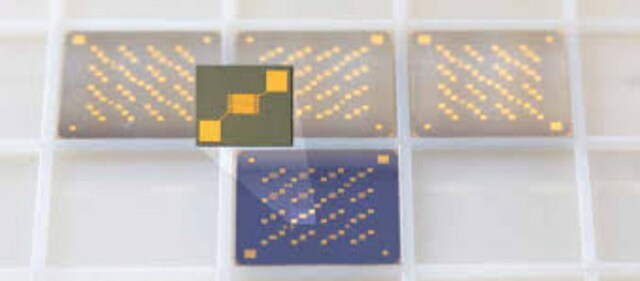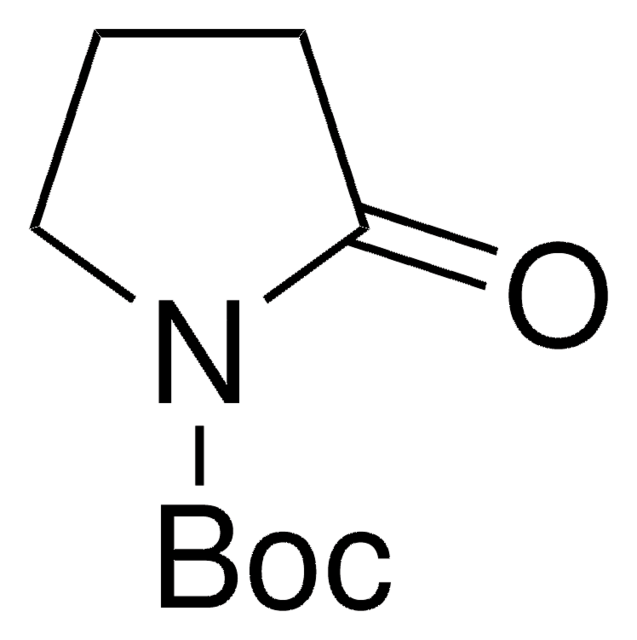FIPMS267
Back-gated LOFET Circuit Substrate
transistors, inverters and ring oscillators, Ti/TiN source/drain, Au contact, 200 nm gate-insulator, chips (diced)
About This Item
Recommended Products
form
chips (diced)
packaging
pack of 1 (wafer of 56 diced chips)
storage temp.
15-25°C
General description
Structure classes: transistors, inverters, and ring oscillators, additional technology test structures, basic circuits
Die size: 15 × 15 mm2
No. of dies: 56
No. of pads: 39 + 2
Pad size: 1200 × 800 μm2
Gate oxide: 200 nm ± 10 nm
Structured layers: 3 (gate, contacts, source/drain)
Gate layer: Ti/TiN, Rs about 10Ω/sq
Contacts: standard 20 × 20 μm2, R around 20Ω
Top layer: 70 nm Au with 10 nm high work function adhesion layer (ITO), by lift-off technique, Rs about 0.65 Ω/sq/ 0.45 Ω/sq
Documentation: included in shipment
Shadow mask: possible, but not required
Probecard: possible, but not required
Protection: resist protection layer (AR PC 5000/3.1, soluable in AZ-thinner or acetone)
Transistors (11)
Connections:
- shared gate (2 pads on different chip sides)
- shared source (2 pads on different chip sides)
- drain for each transistor
- transfer and output characteristics for each transistor to evaluate new organic semiconductors or to monitor organic material fabrication
- designed for parameter extraction to obtain simulation models
Inverters (4)
All 4 inverters are used within the ring oscillator stages or output drivers
Connections
- shared gate IN for the active transistors (2 pads on different chip sides)
- shared gate GEX for the load transistors (2 pads on different chip sides)
- shared VSS
- VDD and output OUT pads for each inverter
- Layout designed for single transistor separation
- Channel length of all transistors: L=5 μm
- Inverter (input/output) characteristics for rapid monitoring of organic materials
- Supply voltages on VDD and VSS (e.g. for p-type organic material: most positive voltage connected to VDD and ground connected to VSS)
- Voltage on IN (gate of active transistor) with value between VDD and VSS
- Different voltage on GEX (gate of load transistor) changes driver/load ratios
- Important: measure output voltages with high impedance volt meter
Ring oscillators (4)
- Connections - left edge (2 ring oscillators)
- shared gates (GATE_1_2) for all load transistors
- shared VSS
- VDD and output OUT pads for each oscillator
- shared gates (GATE_3_4) for all load transistors
- shared VSS
- VDD and output OUT pads for each oscillator
- 7 or 15 ring stages
- Simple inverter layout or inverter layout, designed for single transistor separation
- Different driver/load ratios
- Channel length of all transistors: L=5 μm
- Measure result: oscillation frequency on OUT and calculated inverter delay
- No input signal required
- Supply voltages on VDD and VSS (e.g. for p-type organic material: most positive voltage connected to VDD and ground connected to VSS)
- Different voltage on GEX (gate of load transistors) changes driver/load ratios
- Changing these voltage (more positive or more negative than VSS) triggers oscillation
- Measure output: high impedance oscilloscope probe required
Application
Packaging
Preparation Note
To guarantee a complete cleaning of the wafer / chip surface from resist residuals, please rinse by acetone and then dry the material immediately by nitrogen (compressed air).
Recommendation for material characterization:
If gate currents appear during the characterization of the field effect transistors, considerable variations could occur at the extraction of the carrier mobility. Therefore it is necessary to check the leakage currents over the reverse side (over the chip edges) of the OFET-substrates.
Storage and Stability
Resist layer was applied to prevent damage from scratches.
Expiration date is the recommended period for resist removal only. After resist removal, the substrate remains functional and does not expire.
Legal Information
Choose from one of the most recent versions:
Certificates of Analysis (COA)
Sorry, we don't have COAs for this product available online at this time.
If you need assistance, please contact Customer Support.
Already Own This Product?
Find documentation for the products that you have recently purchased in the Document Library.
Articles
Professors Tokito and Takeda share design principles and optimization protocols for organic electronic devices, focusing on flexibility and low cost.
Professors Tokito and Takeda share design principles and optimization protocols for organic electronic devices, focusing on flexibility and low cost.
Professors Tokito and Takeda share design principles and optimization protocols for organic electronic devices, focusing on flexibility and low cost.
Professors Tokito and Takeda share design principles and optimization protocols for organic electronic devices, focusing on flexibility and low cost.
Our team of scientists has experience in all areas of research including Life Science, Material Science, Chemical Synthesis, Chromatography, Analytical and many others.
Contact Technical Service







